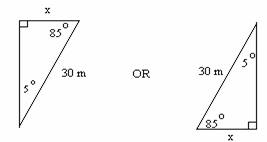Assuming we install one beam in each rectangle, on the sides of the building, we will need 12 beams in total: 6 longer beams and 6 shorter beams.
The length of a beam may be found by using the Pythagorean Triangle property: a2 + b2 = c2
Therefore, the length of a longer beam is equal to: sqrt(152 + 102) = sqrt(325) = 18.03 m
Likewise, the length of a shorter beam is equal to: sqrt(102 + 102) = sqrt(200) = 14.14 m
The total beam length is equal to : (6 x 18.03) + (6 x 14.14) = 193.03 m
The cost, therefore, is equal to: $1000/m x 193.03 m = $193,030
Half of the total beam length from the previous is equal to: 193.03/2 = 96.52 m
The cost, therefore, is equal to: $1900/m x 96.52 m = $183,378
The amount of money saved is equal to: $193,030 - 183,378 = $9,652
The horizontal distance,
x, may be calculated as:
x
= 30 sin(5o) or
x
= 30 cos(85o) = 2.61 m
